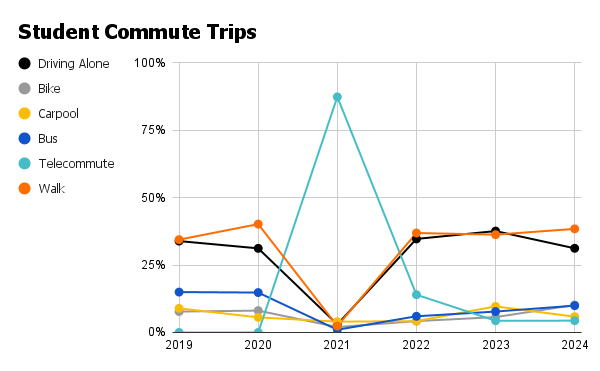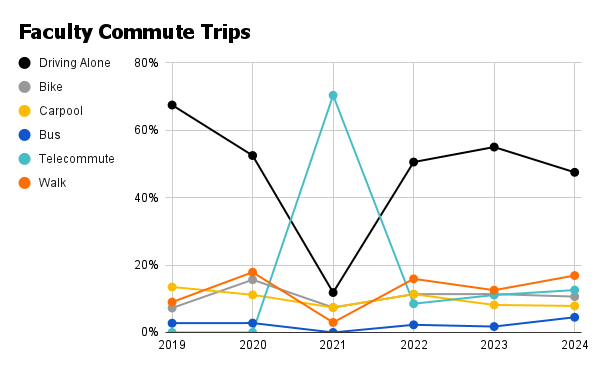Transportation



According to the CSU Transportation and Parking Policy, campuses shall use and promote transportation options that have the lowest total cost of ownership, lowest carbon emissions and best fit for regional transportation needs to mitigate congestion and pollution while maintaining access to campus. The Office of Sustainability works closely with Parking and Commuter Services and regional partners to improve transportation infrastructure, to deploy education and outreach campaigns, and to develop alternative transportation programs. In 2024 Humboldt was recognized a second time as a Bicycle Friendly Business by the League of American Bicyclists.
Goals
Per the CSU Sustainability Policy,
- The CSU will encourage and promote the use of alternative transportation and/or alternative fuels to reduce GHG emissions related to university associated transportation, including commuter and business travel. The Chancellor's Office will establish a baseline for carbon emissions from student, faculty and staff commuting and establish a systemwide reduction target.
- All CSU campuses shall develop and maintain a transportation demand management (TDM) plan to reduce Vehicle Miles Traveled (VMT) and carbon emissions. This plan will be updated every five years and guide the overall transportation and parking program at each campus.
- Campuses shall strive to increase Electric Vehicle (EV), electric bicycle, and other electric mobility and transportation device charging infrastructure and incentive programs to further support campus carbon reduction strategies.
- Campuses shall strive to develop and maintain a long-range plan for transitioning fleet, and grounds equipment to zero emissions, excluding public safety patrol vehicles if necessary. 50 percent of all light duty vehicle purchases will be ZEV by 2025, with no addition of gas-powered light duty vehicles to the fleet after 2035. All small off-road engine (SORE) equipment used for campus grounds will be all-electric by 2035. All buses and heavy-duty vehicles will be ZEV by 2045 in alignment with State regulations.
Status
Commuter emissions can account for 15-20% of the university’s carbon footprint. Single occupant vehicle (SOV) commuting to and from campus contributes the most to traffic congestion, parking constraints, noise and air pollution and emissions. According to the 2023-24 Commuter Survey, nearly half (47.89%) of all commute trips taken by students, faculty and staff combined were by driving alone, a significant amount of which were well within walking, bicycling or transit distance to campus. The number of SOV trips by staff increased by nearly 7% between 22-23 and 23-24. However, faculty SOV commute trips decreased by 7% and student SOV trips decreased by over 6% in that same time period.
See the 2024 Commuter Report for more results from the annual Cal Poly Humboldt Commuter Survey.
Projects
- Jack Pass program uses ID card to ride local bus systems (Parking & Commuter Services)
- Zipcar car-sharing program with five vehicles to reserve by the hour or day (Parking & Commuter Services)
- Humboldt Bikeshare Program with bicycles available to rent at two stations on campus and in Arcata (Office of Sustainability)
- Faculty/Staff RideMatch Service
- Student RideMatch Service and Virtual Ride Board
- Free virtual One-on-One Commute Consultations with a Commuter Specialist
- Bicycle Learning Center student-run bike shop on campus provides instruction, tools and parts (Associated Students)
- Carpool Preferential Parking incentivizes carpooling to campus (Parking & Commuter Services)
- Homeward Bound Bus Charter offers discounted round-trip transportation to Los Angeles and San Francisco (Parking & Commuter Services)
- Establish a Sustainable Transportation Committee
- Electric vehicle charging stations in the G12 parking lot
Next Steps
- Launch Student RideMatch service
- Develop a Commuter Club program to build a campus community of sustainable commuters
- Develop, fund and implement a transportation demand management (TDM) plan
- Develop remote parking with public transportation services to campus
- Better align local bus schedules with class schedules
Learn More and Get Involved
- Parking & Commuter Services provides information on Humboldt’s alternative transportation programs and parking
- The Bicycle Learning Center provides free instruction, tools and parts for bike maintenance and safety. Paid, for-credit and volunteer hours available for students
- Students, faculty and staff on the Sustainable Transportation Committee evaluate and recommend policies, procedures and programs